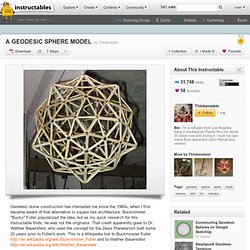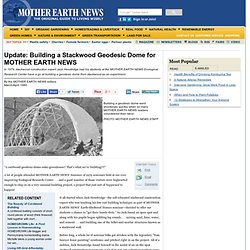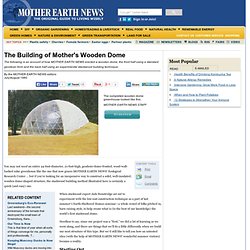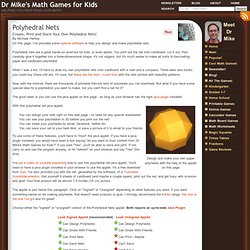

Lord, Chip et al. - Inflatocookbook. Kahn, Lloyd - Domebook 2. Geo-Dome geodesic dome building. Straw Bale Dome. Ways to Cover a Geodesic Dome. Homemade Dome Homes. Do it Yourself: Dome Houses. A GEODESIC SPHERE MODEL. An equilateral triangle is a triangle composed of three sides of equal length.

A flat hexagon (six sides) can be constructed out of six equilateral triangles. To more closely approximate spherical curvature, you want to raise the center of the hexagon a little. You do this by increasing the length two sides of each triangles, the sides that radiate out from the center of the hexagon. The longer you stretch the two sides, the more exaggerated will be the peak in the center of the hexagon. In a flat pentagon (5 sides) the two sides of the triangles that radiate from the center will be shorter than the third side. I don't know the math for making triangles that result in a near-perfect sphere, but I find the idea of lumpy domes and peaky geodesic spheres more interesting anyway. I used the same triangles for making the hexagons and the pentagons.
Do it Yourself Geodesic Dome. How to Roof a Geodesic Dome. BUILDING A WOODEN GEODESIC DOME - PART 1 - STRUT CUTS. Update: Building a Stackwood Geodesic Dome for MOTHER EARTH NEWS - Modern Homesteading. "A cordwood-geodesic-dome-solar-greenhouse?

That's what we're building?!! " A lot of people attended MOTHER EARTH NEWS' Summer of 1979 seminars held at our ever improving Ecological Research Center . . . and a good number of those visitors were bighearted enough to chip in on a very unusual building project, a project that just sort of happened to happen! It all started when Jack Henstridge—the self-educated stackwood construction expert who was teaching his low cost building technique as part of MOTHER EARTH NEWS' Earth-Sheltered Homes seminar—decided to offer our students a chance to "get their hands dirty. " So Jack found an open spot and along with his pupils began splitting log rounds . . . mixing sand, lime, water, and cement . . . and building one of the billet-and-mortar structures known as a stackwood wall. Before long, a whole lot of seminar folks got stricken with the legendary "Tom Sawyer fence painting" syndrome and pitched right in on the project.
The Building of Mother' s Wooden Dome - Green Homes. You may not need an entire 44-foot-diameter, 21-foot-high, geodesic-dome-fronted, wood-wall-backed solar greenhouse like the one that now graces MOTHER EARTH NEWS' Ecological Research Center ... but if you're looking for an inexpensive way to construct a solid, well-insulated, wooden dome-shaped structure, the stackwood building method illustrated here is certainly a quick (and easy) one.

When stackwood expert Jack Henstridge set out to experiment with the low-cost construction technique as a part of last summer's Earth-Sheltered Homes seminar—a whole crowd of folks pitched in, barn raising style, to help create what is (to the best of our knowledge) the world's first stackwood dome. Needless to say, since our project was a "first," we did a lot of learning as we went along, and there are things that we'll do a little differently when we build our next structure of this type. Starting Out Our dome began, of course, with the construction of its 44-foot-diameter foundation. Origami dodecahedron. Polyhedral Nets. On this page, I've provided some special software to help you design and make polyhedral nets.

Polyhedral nets are a great hands-on exercise for kids, or even adults. You print out the net onto cardboard, cut it out, then carefully glue it together into a three-dimensional shape. It's not origami, but it's much easier to make all sorts fo fascinating paper and cardboard polyhedra! When I was a kid, I'd have to draw my own polyhedral nets onto cardboard with a ruler and a compass. There were also books you could buy (there still are, I'm sure, but these are the best I could find) with the nets printed with beautiful patterns.